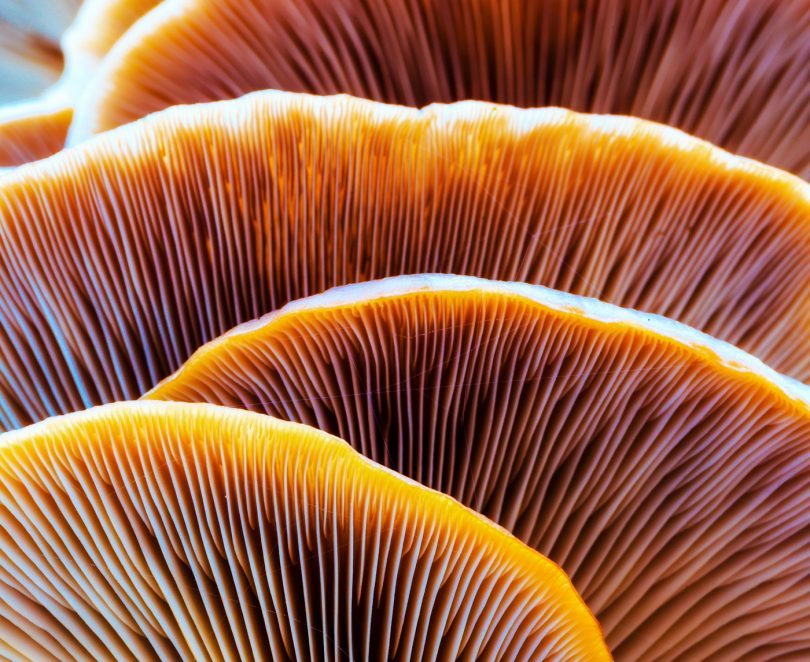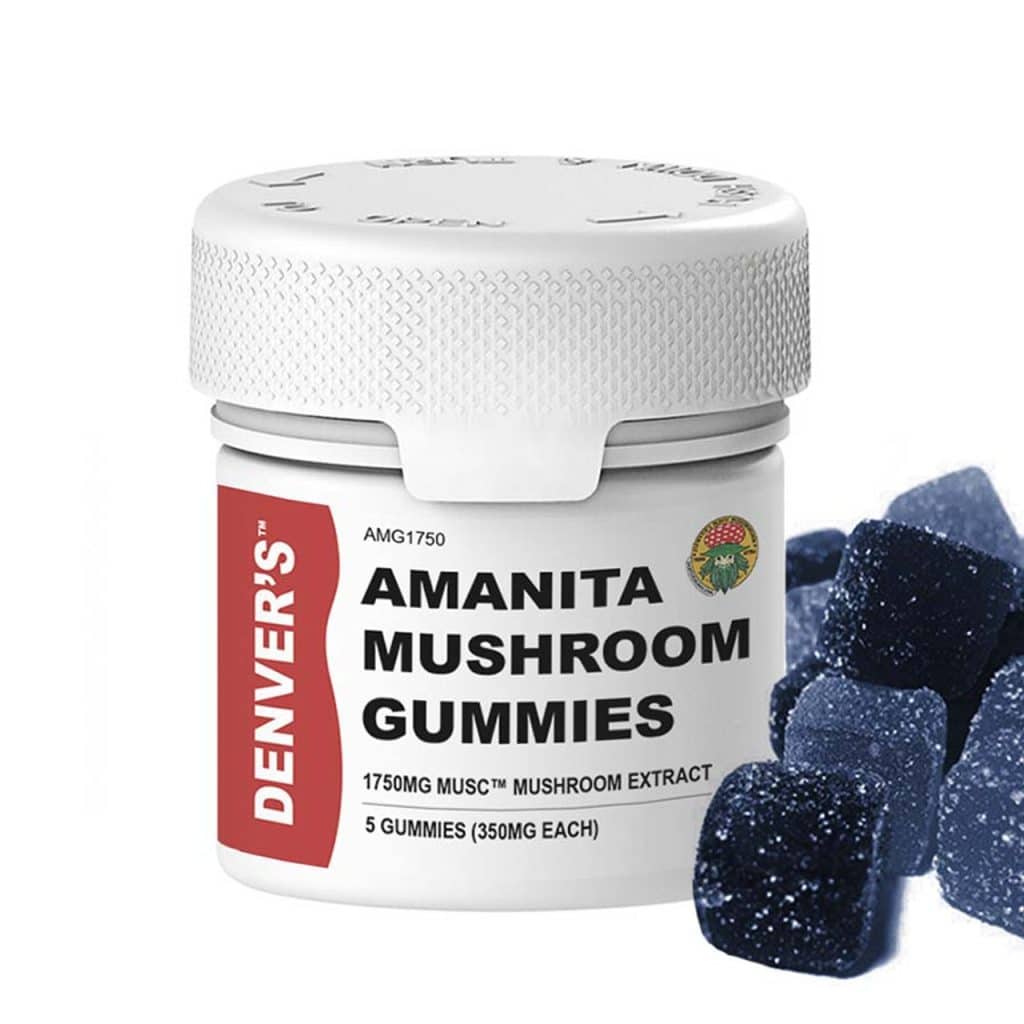Mushrooms are widely regarded as a superfood because they taste great, add richness and can elevate most meals, and are packed with nutrients, vitamins, and antioxidants that translate to incredible health benefits for consumers. If you’re looking for one type of food to add to your diet that could really make a difference in your overall health, fungus is truly where you get the most bang for your buck.
Why mushrooms are amazing
In addition to being considered gourmet, mushrooms are one of the most nutritious foods on earth. They’re a low-calorie source of fiber, protein, potassium, and antioxidants, known to have the ability to mitigate (or completely heal in some instances) many serious health conditions. The list of ailments that can benefit from mushroom consumption is vast but includes: diabetes, cancer, heart disease, inflammation, cancer, Alzheimer’s, high blood pressure.
Not only can fungi help treat existing conditions, but they can make you healthier overall. The anti-inflammatory effect of fungi is proven to greatly improve immune function and efficiency. Experts beleive their powerful anti-inflammatory effects are the reason for this. Numerous studies have found that mushrooms help stimulate macrophages in the immune system, amplifying their ability to fight disease.
New: Amanita Muscaria Mushroom Gummies
In that same vein of general wellness, research indicates that mushrooms, when combined with other healthy lifestyle choices like regular exercise, are key to weight loss and maintenance. Mushrooms have low calories, no cholesterol, and no fat, so they’re a great way to get the recommended amount of dietary protein for building muscle without all the unnecessary compounds that can make you gain fat.
Another interesting feature of mushrooms, one that was only recently discovered, and by accident to boot, is that they can produce antibiotic compounds to fight a huge range of bacteria. If exposed to certain bacterium, mushrooms will create metabolites to kill that pathogen. This discovery could be pivotal in changing the way we treat antibiotic resistant bacterial infections.
Fungus as a healing superfood is a somewhat new concept in the western world, but they’ve been utilized in eastern medicine and nutrition for centuries. The oldest official record of medicinal compounds from Traditional Chinese Medicine, dating from the 29th century BC, lists several mushroom species. In recent years, they’ve become a popular meat substitute as we’ve seen a steady rise in vegetarianism and veganism across the globe. They’re also being discussed with greater frequency in the realm of mental health, especially psilocybin mushrooms.
From common grocery store types like creminis, to incredibly rare psychedelic varieties, all edible mushrooms are extremely beneficial. Remember that some are poisonous, so don’t go running around the woods eating unidentified fungi. But do try to incorporate more healthy mushrooms into your diet. Whether you’re adding shitakes to dinner once a week or microdosing with liberty caps, you’re sure to experience some positive changes. Remember to subscribe to The Psychedelic Weekly Newsletter to learn more about mushrooms and the psychedelic industry as a whole.
Want Daily Updates?
Subscribe to Cannadelics News on Telegram!
Lion’s Mane
Hericium erinaceus is an edible mushroom hailing from the tooth fungus group. It’s native to three different continents, North America, Europe, and Asia, and they resemble of clump of long fuzzy spines growing on various hardwood trees. They can be eaten raw, cooked, dried, or steeped in soup and tea. They have a strong seafood/shellfish flavor, like crab or lobster. Lion’s mane extracts are commonly found in health supplements, and Asian countries like China, India, Japan, and Korea have been using these mushrooms medicinally for ages.
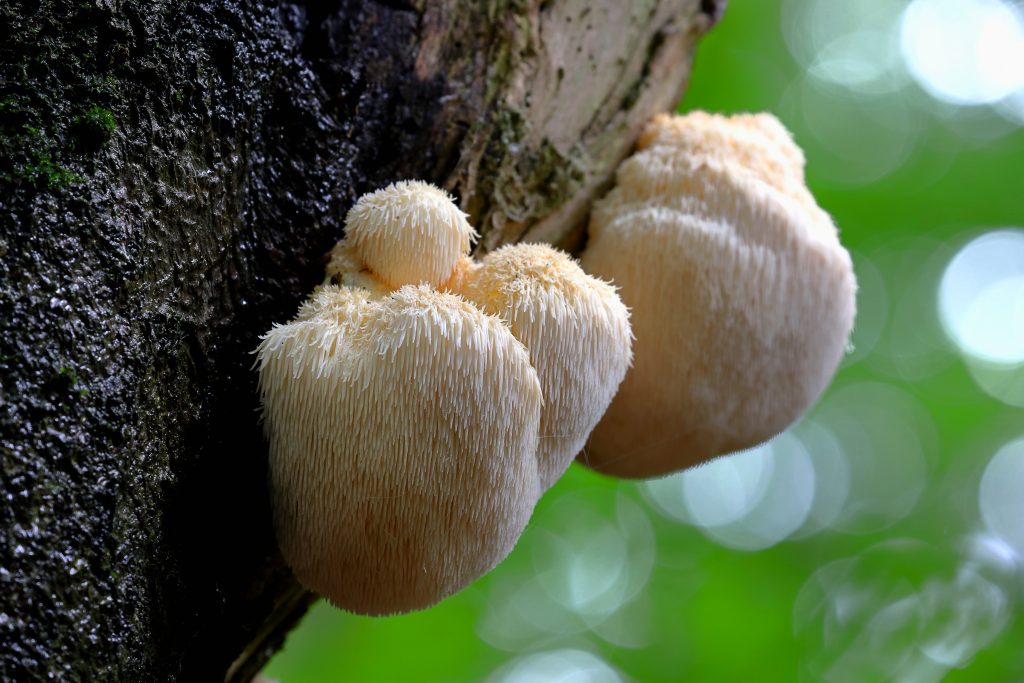
Research has found that lion’s mane mushrooms contain high levels of two compounds that can aid in brain cell regeneration: hericenones and erinacines. These compounds can also prevent neural damage caused by amyloid-beta plaques, which are abnormal clusters of protein fragments built up between nerve cells; commonly found in the brains of people with Alzeihmer’s.
Lion’s Mane mushrooms are also known to be extremely effective in fighting cancer. This theory has been tested and proven numerous times over with several different types of human cancer cells in test tubes. Liver, colon, stomach, and blood cancer cells have been studied and Lion’s Mane was successful in destroying them all.
Cordyceps

Cordyceps are not quite mushrooms, but rather a genus of parasitic fungi that grows on insect larvae. The fungus attacks the host and replaces its body tissues with stems that grow on the outside of the larva’s body. Over 600 species of cordyceps have been discovered all over the world, although most are concentrated in Asia and medical literature has focused heavily on two types: Cordyceps sinensis and Cordyceps militaris
The remnants of these infected insects have been harvested, dried, and used in Traditional Chinese Medicine formulations to treat inflammation, fatigue, low sex drive, kidney disease, and many other illnesses. Formal research on this fungus is limited, but anecdotal evidence is abundant.
Additionally, cordyceps are believed to increase the body’s production of adenosine triphosphate (ATP), source of cellular energy for muscle contractions, nerve impulse propagation, and other physiological functions. In Eastern cultures, cordyceps are often used by the elderly for the anti-aging properties – attributable to their high levels of antioxidants – as well as to battle weakness and fatigue and improve their sex lives.
Reishi
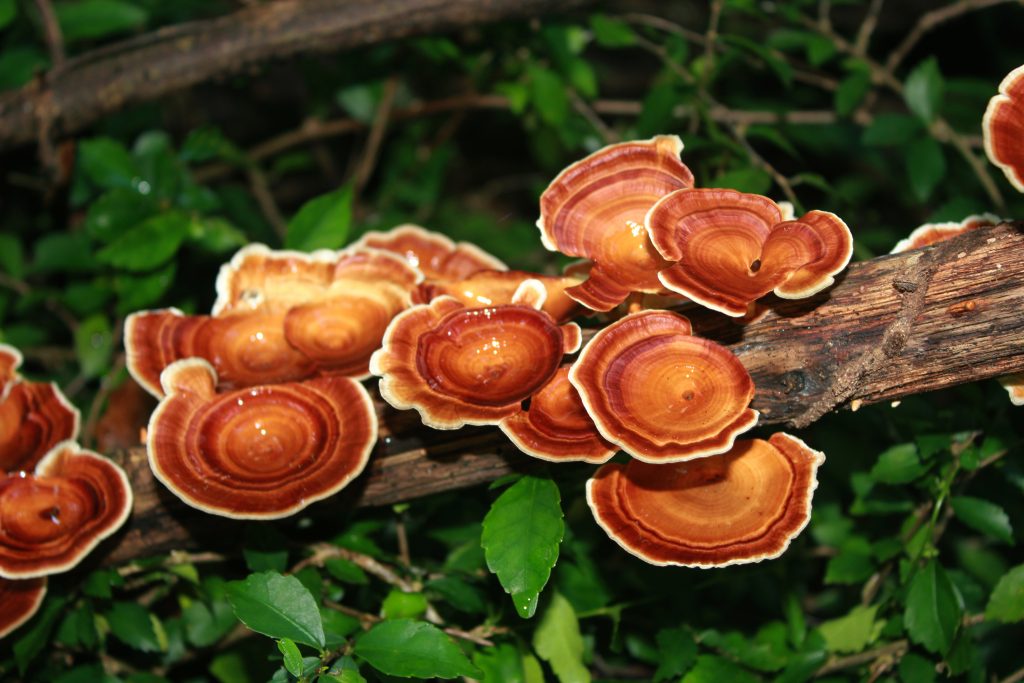
Ganoderma lucidum, also known as Lingzhi or Reishi, is a reddish-brown colored, polypore fungus with a banded cap and peripheral stem. Fresh reishi look soft and flat, and they grow at the base of deciduous trees, particularly maples. They can be eaten fresh or dried, in tinctures or extracts, or in powdered form that can be added to smoothies or drinks.
Reishi mushrooms contain a bunch of different compounds that are beneficial to human health, such as triterpenoids, polysaccharides and peptidoglycans. Although many mushrooms lack the scientific literature to back up their benefits, that is not the case with reishi. As a matter of fact, over 3,300 research papers have been published on these mushrooms in the US National Library of Medicine alone.
Although all mushrooms are believed to have positive effects on immunity, reishi mushrooms are especially known for this. Studies have found that reishi mushrooms can affect the genetic makeup of white blood cells, making them more effective immune system agents against pretty much all pathogens.
Morels

Morchella, or true morels, are a genus of edible sac fungi that can be found in temperate regions around the world including North America, Turkey, China, the Himalayas, India, and Pakistan. They are a prized ingredient in many types of cuisine, especially French. Cultivation of these mushrooms can be tricky, so harvesting wild morels has become a multi-billion-dollar industry.
It’s important not to confuse true morels with false morels, a term loosely applied to describe Gyromitra esculenta, Verpa bohemica, and other species morel lookalikes. Although some false morels can be eaten safely, the ones in my area and many others are extremely poisonous. So toxic in fact that even fumes from cooking the mushrooms can cause dizziness and nausea. When cut down the middle, true morels have a hollow cap and a stem that connects at the bottom of the cap, whereas false morels have a thick fibrous stem that runs through the entire cap and connects at the top. Check the photos on this page to learn more.
That said, I personally love morels. You can’t really find any in grocery stores but I’m blessed to have them growing in abundance in my yard in Indiana. I live in the woods near some small creeks and a large lake and find them frequently in open fields along the forest edge, near oak, elm, ash, and aspen trees.
Like all mushrooms, morels have many benefits but one thing that makes them unique is that they have one of the highest amounts of vitamin D out of any edible mushroom species. Only 100 grams of morels (less than 1 cup) will provide you 34% of the daily required levels of vitamin D. They’re also loaded with potassium, vitamins, copper, and antioxidants.
Turkey tails
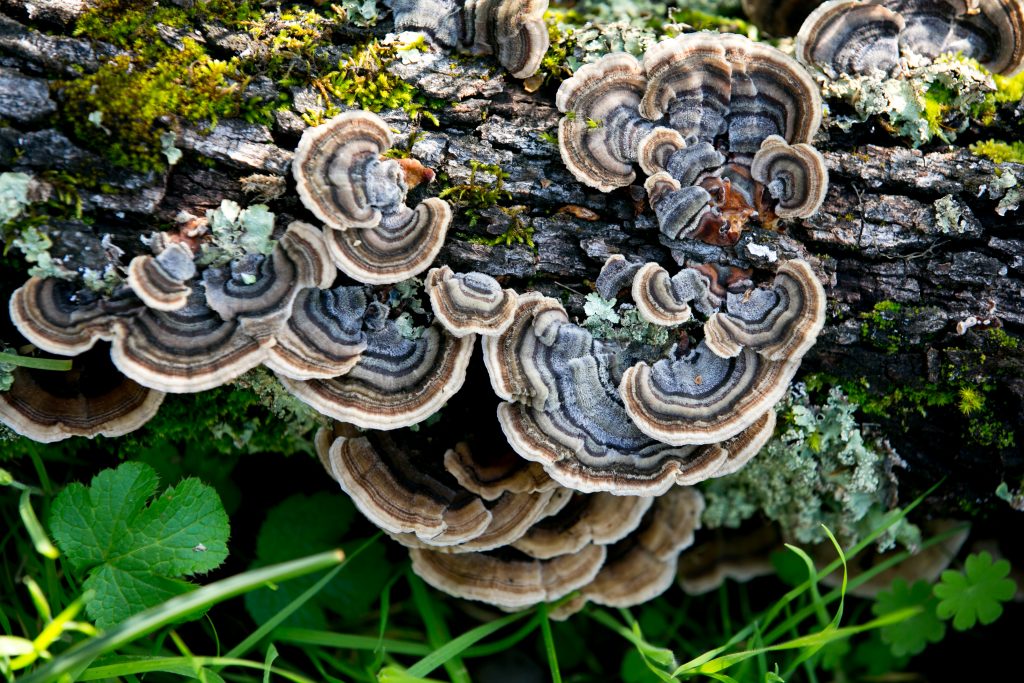
Turkey tails, also known as Coriolus versicolor, Polyporus versicolor, or Trametes versicolor (meaning ‘of several colors’) is a common polypore mushroom that grows in humid areas all over the world. They are technically considered to be inedible, only because they harden when cooked and don’t taste good, but they can be turned into powders, tinctures, and extracts for use in various products.
Like reishi mushrooms, Turkey tails are also revered for their immune-boosting abilities. Turkey tails contain Polysaccharopeptides, which are protein-bound carbohydrates that block inflammation and activate beneficial immune cells. Because of this, Turkey tail mushrooms are used in combination with pharmaceutical treatments to enhance their efficiency. For example, a review of 13 studies found that chemotherapy patients who were consuming 1-4 grams of Coriolus versicolor had a greater chance of survival than those who did standard treatments alone. Overall, Turkey tails contributed to a 9% reduction in 5-year mortality.
Another unique benefit of Turkey tails is that they can help regulate your gut bacteria, which plays a pivotal role in overall health. Many conditions stem from an imbalanced gut microbiome. A study of 24 healthy volunteers found that this strain of mushroom contains prebiotics that suppressed the growth of harmful bacteria like E. coli, Salmonella, and Shigella. Outside the digestive system, Turkey tails can also prevent the growth and spread of Staphylococcus aureus.
Chaga
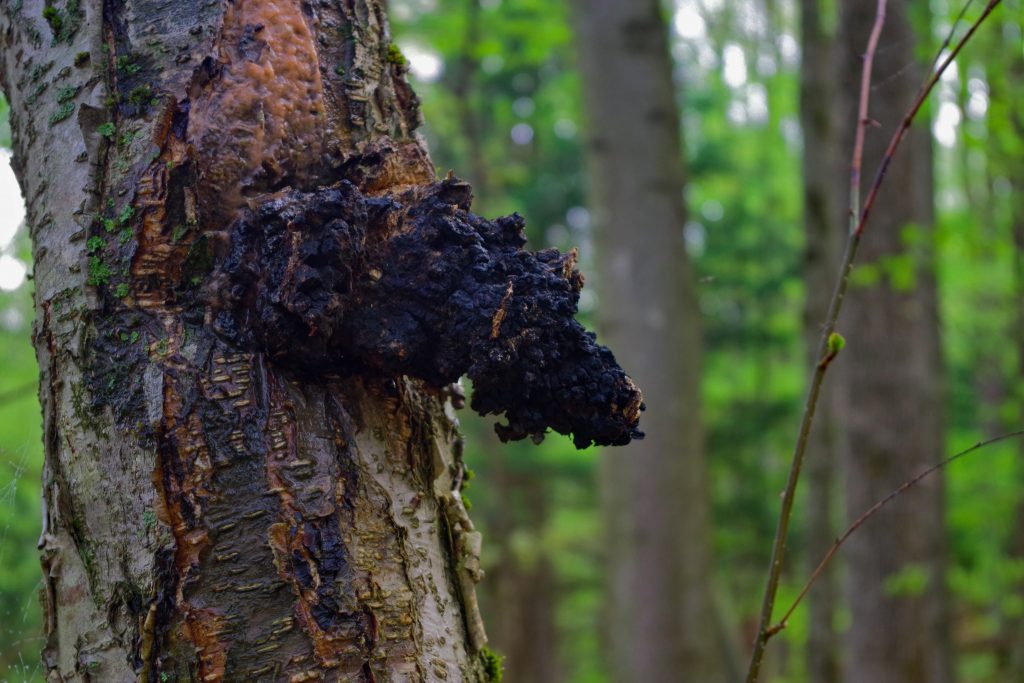
Chaga, formally known as Inonotus obiquus, is a parasitic fungus from the Hymenochaetaceae family. They grow on a lot of different trees but have an affinity for birch. Chaga mushrooms have been used medicinally for hundreds of years in Siberia and other parts of Asia. They’re not pretty compared to other mushrooms and resemble an irregularly-shaped clump of burnt charcoal, but they’re one of the more popular species on this list and are becoming better-known in the Western world as well.
Chaga mushrooms contain a wide variety of different vitamins, minerals, and nutrients such as B-complex vitamins, vitamin D, potassium, rubidium, cesium, amino acids, fiber, copper, selenium, zinc, iron, manganese, magnesium, and calcium. The extract from this fungus is commonly used to help lower cholesterol and prevent heart disease.
During a 2-month study of lab rats on chaga, the extract was found to reduce levels of LDL cholesterol (bad cholesterol) and increase levels of HDL cholesterol (good cholesterol), thanks to their high levels of antioxidants. Additionally, studies have demonstrated that eating chaga mushrooms regularly can reduce oxidative stress, lower blood pressure, and greatly reduce the risk of having a heart attack or stroke.
Maitake
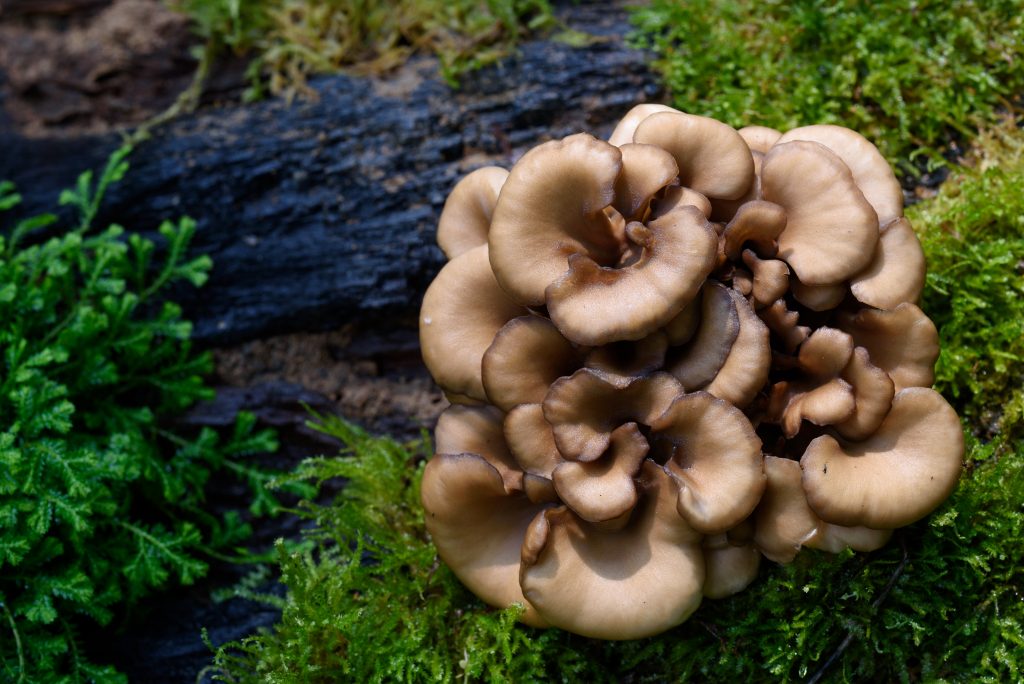
Grifola frondosa, also known as Hen-of-the-woods or Maitake (not to be confused with shiitake) is a polypore mushroom found in Japan, China, Europe, and North America. It grows at the base of trees, mainly oaks, and can be found in late summer to early fall. The word “maitake” means dancing mushroom in Japanese. As the story goes, people were so elated when they found this mushroom in the wild that they ‘danced for joy’… and no, it’s not psychedelic.
Although Maitakes are sometimes used in recipes, they are considered a medicinal mushroom and are more often utilized in therapeutic settings. Maitake mushrooms are what’s known as adaptogens, or non-toxic plants that can be used to regulate body systems, both physical and mental. They’re one of the best mushrooms to use for ‘resetting’ the body and creating homeostasis. Maitakes have shown more promising results in treating and preventing various health conditions than other mushroom species.
A 2015 study also discovered that maitake mushrooms can be effective in treating type 2 diabetes, which is on the rise. Statistics show that lifestyle choices (like diet, lack of exercise, and obesity) are responsible for up to 85% of new type 2 diabetes cases. In the study, maitake mushrooms had a positive impact on rats with the disease.
Psilocybin

Psilocybin mushrooms, commonly known as magic mushrooms or shrooms, are a polyphyletic, informal group of fungi that includes Copelandia, Gymnopilus, Inocybe, Panaeolus, Pholiotina, Pluteus, and Psilocybe. Psilocybin, the main psychoactive compound in these mushrooms, is actually found in over 100 species around the world.
Psilocybin has a strong effect on serotonin receptors in the brain, including some in the cerebral cortex and thalamus regions. Although magic mushroom use – casually referred to as “shrooming” – is commonly associated with hippies, artists and others that tend to live a more alternative lifestyle, their consumption actually dates back thousands of years. Historically, they’ve been used to aid in religious ceremonies and are still considered a gateway to some very profound spiritual experiences.
Psilocybin mushrooms also have some powerful therapeutic benefits. They have already been decriminalized in a few locations around the world as researchers dive into their potential to treat numerous disorders. Areas of interest mainly include mood disorders such as anxiety, OCD (obsessive compulsive disorder), and substance addiction.
Unlike other mushrooms on this list, there is an issue of legality with psilocybin mushrooms, meaning that they are still illegal in most countries. In the United States, their active ingredient is listed as a schedule 1 narcotic, and so their possession and cultivation is prohibited. A few pockets of the world are changing these laws though, as the public becomes increasingly aware of their health benefits.
Final thoughts
The mushrooms listed above are just some of my personal favorites, but you can benefit from even the most common species out there. Adding even some baby bellas or white buttons to your meal plan a couple times a week can be incredibly advantegous, while microdosing with magic mushrooms on a regular basis could be a game changer for your mental health. As long as what you’re eating isn’t poisonous, you really can’t go wrong with any type of mushroom, they’re all incredible!
Hello all! Welcome to CBDtesters.co, your ultimate online destination for the most relevant and thought-provoking cannabis and psychedelics-related news globally. Read through the site regularly to stay on top of the constantly-moving world of legal drugs and industrial hemp, and sign up for The Psychedelics Weekly Newsletter, so you never miss a thing.
Disclaimer: Hi, I’m a researcher and writer. All information in my articles is sourced and referenced, and all opinions stated are mine. I am not giving anyone advise, and though I am more than happy to discuss topics, should someone have a further question or concern, they should seek guidance from a relevant professional.

